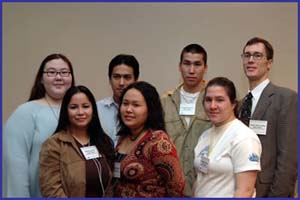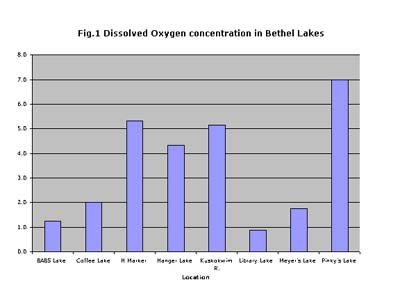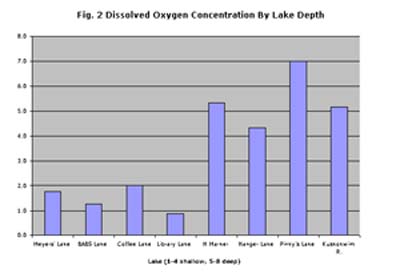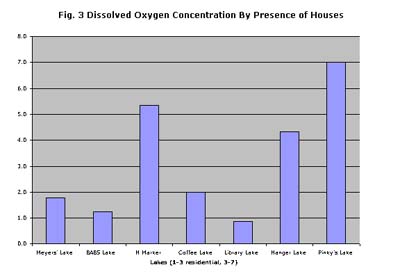
This paper was written as part of the 2004 Alaska Ocean Sciences Bowl high school competition. The conclusions in this report are solely those of the student authors.
Effect of Housing on Dissolved Oxygen in Bethel, Alaska Lakes
Authors

- Abstract
- Bethel, Alaska
- Yupik Subsistence
- Issues of Dog Team Waste
- Dissolved Oxygen and Northern Pike
- Broad Whitefish
- Blackfish
- Methods
- Results
- Conclusion
- Figures and Tables
- Bibliography
Abstract
Our research team tested seven lakes and one river in Bethel, Alaska. We took samples of the water and tested how much dissolved oxygen existed in the residential and non-residential lakes. We were trying to find out if the location of the lakes had any effect on the oxygen level. The results have shown that residential lakes had more dissolved oxygen than non-residential lakes. We then discovered there is possibly more reasons as to why the lakes are lacking dissolved oxygen. Depth has extreme effect on the dissolved oxygen concentration in the lakes.
Bethel, Alaska
Bethel is a small town located in Southwest Alaska. Yup'ik Eskimos founded it. They called the village Mamterillermiut, meaning smokehouse people, named for a nearby fish smokehouse. The original Bethel was built around the mouth of Brown Slough. Years passed and it expanded on to the tundra. Today, the roads of Bethel circle the tundra with scattered neighborhoods along the roads.
During the 1880 U.S. Census, there were 41 people. Bethel is now the largest community out of 56 surrounding villages in Southwestern Alaska (http://www.bethelak.com/). The current population demographics are about 6,896. 68.9% Alaskan Natives, 21.8% Caucasian, 0.7% African American and 11.2% of other races. 52.5% Males and 47.5% Females (U.S. Census Bureau, 2000). The culture in Bethel is very important. Many Yup'ik Eskimos speak their language and maintain their traditional ways. For example, Camai Festival is a popular Eskimo dance, craft, and fur festival Bethel has annually. Nearby villages and other different regions come and teach others or tell a story about their dances. The elders say the festival is a celebration that means families gathering together.
Yupik Subsistence
In present day, many Yup'ik natives do not depend on the subsistence way of life. Most of the time, we Yup'iks, gather fish and dry or freeze them for winter food. We mainly do this in case we have no other Western food to eat. Either that or we wanted to soothe our inherited cravings for them. Some examples of the fish we collect are leqruuyaq (pike, Esox lucius), akakiik (white fish, Coregonus nasus), and can'giit (black fish, Dallia pectoralis). We catch most of the fish during winter and spring, and occasionally during the summer. The way we catch white fish and pike is by the manner of ice jigging and some times by set nets. The way we catch black fish is quite complicated. Sometimes we use a dip net for shallow streams and other times we use a metal wire or wooden fish trap that we call taluuyaq. We set the taluuyaq in the water and schools of black fish enter the fish trap with no way out.
Aka Tamaani (back then) our ancestors depended on the subsistence way of life. They rarely had enough money to buy western food, so they caught and prepared their own food. Our ancestors depended mainly on fish, fresh, dried, or frozen. Unlike many of us today, they provided their families with enough food to last all winter till they could begin re-harvesting during the spring and summer. Now days, many times during feasts Yup'iks eat delicacies such as boiled black fish, dried pike, white fish with seal oil, and white fish soup. Reasons why many people do not harvest any more consists of our knowledge that the water is polluted and that some have lost a taste for them.
Issues of Dog Team Waste
According to Beverly Hoffman, (personal communications, 2003), there are nineteen dog teams in Bethel, both professional and recreational. There are probably about fifty teams on the lower Kuskokwim River and even more on the Yukon. On average, there are about twenty to thirty dogs to a kennel, but some can have as few as five. Almost all of Bethel residence own pet dogs.
People have different ways of dealing with their dogs' feces. Some people will gather it up and bring it to the dump. Others will carelessly let it pile up. This will cause the surrounding ground to become fertilized. The near by lakes and rivers, which are Meyer's, BABS, H marker, and the Kuskokwim River, will become contaminated and polluted from runoff due to rain. Because runoff from rain flows downhill, it leaks into these lakes. This causes them to become more contaminated of dog yard waste.
It would be a lot more considerate if the feces were to be picked up or moved to another area to make the ground fertilized which will cause more plants to grow. However, we are concerned that dog yard waste may be causing excessive algae growth increasing biochemical oxygen demand in local lakes.
Dissolved Oxygen and Northern Pike
Pikes inhabit deep, slow waters of large rivers due to the depletion of oxygen in shallow water in wintertime. Northern Pike live in many lakes, rivers, and sloughs of our region, (Alaska Department of Fish & Game). They also range from the Interior to the Arctic Coast, from the Canadian Border to the Seward Peninsula, and Southwest to the Bristol Bay Drainages, (Alaska Department of Fish & Game).
People in Alaska catch pike by jigging for them in the wintertime. In the summer time, others usually use nets to catch pike. Some people use fishing rods to catch pike recreationally. Local pike are found in the Kuskokwim in the winter. When the lakes flush out in the breakup, pike move back into the lakes until freeze-up, (Michael Chase, personal communications, 2001).
People can preserve pike during the wintertime by storing them in cold areas to stay frozen. Most of the pike people catch are used as dog food. In the summer, people hang-dry pike to later on eat them with seal oil. Some people cook them or just store them in the freezer to eat on another occasion.
Broad Whitefish
The Broad Whitefish is larger than the Humpback Whitefish. They have a deeper head, shorter snout, shorter gill rakers, and a shorter and blunter snout than the Humpback Whitefish. Broad Whitefish are usually referred to as the true Whitefish, (George 1997).
They can be found in the Yukon and Kuskokwim River drainages. They are also found in the Bering Sea, Chukchi Sea, and the Arctic Ocean drainages, (George 1997). Broad Whitefish are known to feed on small creatures at the bottom of the water. They eat small clams, snails, aquatic insects, larvae, and freshwater shrimp.
Broad Whitefish Spawning begins in the fall around October, as for other fish in the upper reaches of rivers. They are important to Alaska Natives because of their commercial value and they provide recreational fishing opportunities.
Blackfish
The Alaskan Blackfish is a unique fish. They have a modified esophagus capable of gas absorption. This means they can exist off atmospheric oxygen.
They found out that a female blackfish reaches sexual maturity at the length of eighty millimeters. Some people have found blackfish up to thirteen inches long.
Female blackfish can lie up to forty to three hundred eggs at intervals throughout their entire spawning period, (Armstrong 1994). The blackfish eggs hatch in a short period of time, which is about nine days. They hatch at six millimeters long.
People catch blackfish using a trap, which is called taluuyak in Yup'ik. They catch them in streams that lead to rivers. Many people eat them raw, but others boil them.
Methods
Our science class spent some time outside experimenting with the surrounding lakes and rivers of Bethel. Of course the weather wasn't at all tropical, so that meant going out dressed in all the winter gear necessary. Our goal was to test the level of dissolved oxygen in the residential and non-residential lakes. Did the lakes located in residential areas have a higher oxygen level than the lakes in non-residential areas? Did the size and the depth of the lakes have any effect on the oxygen level? We answered these questions by proceeding with the following methods.
We chose seven surrounding lakes and one river, the Kuskokwim. Three of the lakes were residential and subject to contamination of dog feces, Meyers, BABS, and H Marker Lakes. Four were non-residential and weren't subject to contamination of dog feces, Coffee, Hanger, Library, and Pinky's Lakes. At the time the surface of the water was completely frozen. We split up into groups and tested each lake one at a time. Each group went out onto the lakes and chipped three holes using a standard steel ice pick. Although it was terribly cold outside, we continued chipping the ice until we reached water. The ice thickness was about two feet. When that happened the water would rise. We then took samples of the water using a graduated cylinder. We collected twenty-five milliliters of water and measured the oxygen level using a vacuum-like syringe. It would then change the color of the water into a certain shade of blue. The darker the blue, the higher the oxygen level. We compared it with known concentrations and recorded the results.
Results
The results of the tests we performed were somewhat inconclusive. We took three samples of water from each lake and from that data, we have an average oxygen level in parts per million. (see Table 1).
The results for Myers' Lake, which is a shallow and residential lake, averaged at a low 1.8ppm. The size of the lake ranked at number five out of the seven. This means its is better recognized as a medium-sized lake. BABS Lake, a small, shallow, and residential lake, averaged at 1.3ppm. It was ranked the sixth largest lake.
H Marker Lake, a large and residential lake, averaged at 5.3ppm. It is also about a 10-foot deep lake. H Marker Lake was the second largest lake. Coffee Lake, which is a shallow and non-residential lake, averaged at 2.0ppm. It is a medium sized lake, which was ranked as the third largest lake. Hanger lake, a deep, large, and non-residential lake, averaged at 4.3ppm. It was the largest of all seven lakes. Library Lake, which is a shallow and non-residential lake, averaged at 0.9ppm. This was the smallest lake we tested. The part of the Kuskokwim River we tested is on the coast of the city of Bethel, so I would refer to it as residential. It averaged at 5.2ppm. There are a lot of fish camps along the river, and people go out in their boats as well. Although the water is pretty deep, it is polluted.
Pinky's Lake, which is a relatively deep lake, averaged the highest at 7.0ppm. This was in fact a non-residential lake ranking the fourth largest.
Conclusion
According to the results, it seems as though the lakes that are located in non-residential areas have a higher level of dissolved oxygen. (see Fig. 3). This is possibly because there aren't any homes or pets surrounding the lake that could pollute it. Therefore, this causes the lake to be less depleted of oxygen. Although the lakes that were located in residential areas had a low level of dissolved oxygen, there was one that had a relatively high level of oxygen. It seems as thought the H Marker Lake, which was in fact a lot deeper than the other residential lakes, was one of the lakes with the highest level of dissolved oxygen. Is it possible that the depth of the lake had any effect on how much oxygen existed in it? This, however, is an inconclusive question.
The lakes with more depth were the ones that had more dissolved oxygen. (see Fig. 2). The shallower lakes had less dissolved oxygen. Both of which were residential and non-residential. According to the results, it doesn't seem a though the size of the lake had any effect on the amount of dissolved oxygen in the lake. Basically, we have come to conclude that the location of the lake has effect on how much dissolved oxygen it contains, but the depth of the lakes have a more significant effect.
Perhaps considering a plan to composting dog yard waste would be beneficial to those who use theses lakes recreationally. It would also increase the level of dissolved oxygen concentration in the surrounding residential lakes of Bethel. This could mean issuing a petition to the city to develop a way of eliminating dog feces before more runoff pollutes theses lakes. Although lack of funds to go forth with this plan is a possible struggle, the city should enforce all dog owners to compost the waste. By doing so, this will provide more sanitary lakes and rivers. It will also reduce the risk of disease to residents who fish and boat.
Figures and Tables
Table 1. Dissolved Oxygen Data For Bethel Lakes
Lake |
Sample 1 |
Sample 2 |
Sample 3 |
Avg. |
Residential? |
Size |
Category |
Depth |
Meyers' Lake |
1.5 |
2.0 |
1.8 |
1.8 |
yes |
5 |
Medium |
shallow |
BABS Lake |
0.5 |
2.0 |
1.3 |
1.3 |
yes |
6 |
Small |
shallow |
H Marker |
7 |
5 |
4 |
5.3 |
yes |
2 |
Large |
deep (10ft) |
Coffee Lake |
1 |
2 |
3 |
2.0 |
no |
3 |
Medium |
shallow |
Hanger Lake |
4 |
4 |
5 |
4.3 |
no |
1 |
Large |
deep (10ft) |
Library Lake |
0.8 |
1 |
0.8 |
0.9 |
no |
7 |
Small |
shallow |
Kuskokwim River |
5 |
5.5 |
5 |
5.2 |
||||
Pinky's Lake |
6 |
7 |
8 |
7.0 |
no |
4 |
Medium |
rel. deep |

Click to view larger image.

Click to view larger image.

Click to view larger image.
Bibliography
Armstrong, Robert H. Alaska Blackfish. Wildlife Notebook Series. Alaska Department of Fish and Game. 1994
Joos, F., G.-K. Plattner, T. F. Stocker, A. Körtzinger, and D. W. R. Wallace, Trends in marine dissolved oxygen: Implications for ocean circulation changes and the carbon budget. EOS, 84(21), 197-204, 2003. [Marker]
George, Jackie Paul. Whitefish-Fish, Fire, and Water. Alaska Native Knowledge network. University of Alaska Fairbanks, 1997.
Chase, Michael. Former Board Member. Kuskokwim Fisherman's Cooperative. P.O. Box 195, Bethel, Alaska 99559, 907-543-2354
Hoffman, Bev. Founding Member Kusko-300 Sled Dog Race 907-543-3300. c/o LKSD, P.O Box 305, Bethel, Alaska 99559.
This page is HTML 4.01 validated. Last modified 18-Mar-2004 . Contact ASG web coordinator.